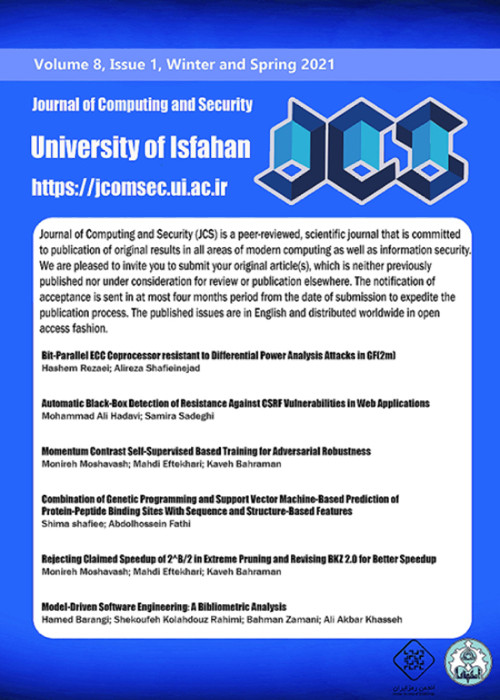فهرست مطالب
Journal of Computing and Security
Volume:7 Issue: 2, Summer and Autumn 2020
- تاریخ انتشار: 1399/11/15
- تعداد عناوین: 4
-
-
Pages 95-101On-chip networks provide a scalable infrastructure for moving data among cores in many-core systems. In future technologies, significant amounts of dynamic energy are dissipated for data movement on on-chip links. This paper proposes Sig-NoC, a predictable approach via signature encoding and transition signaling to reduce switching activity on links. Also, we show that link energy dominates in future technologies. Sig-NoC makes the switching activity proportional to the number of 1s per data in the source by using transition signaling. We estimate the energy of each packet at the source of routing in NoC. Therefore, we reduce the number of 1s for high energy packets through signature coding in the source. Sig-NoC mechanism encodes the packets once at the source and decodes them at the destination only; therefore, it has virtually no impact on performance. Simulation results on NAS and Phoenix benchmark suits on 4X4 NoC indicate that Sig-NoC achieves an average of 28% reduction in the overall NoC energy.Keywords: Interconnection Networks, Network on Chip, Data Movement, Coding
-
Pages 103-117In this paper, we propose a new method to launch a more efficient algebraic cryptanalysis. Algebraic cryptanalysis aims at finding the secret key of a cipher by solving a collection of polynomial equations that describe the internal structure of the cipher. Chosen correlated plaintexts, as what appears in higher order differential cryptanalysis and its derivatives such as cube attack or integral cryptanalysis, forces many linear relations between intermediate state bits in the cipher. In this paper, we take these polynomial relations into account, so it becomes possible to simplify the equation system arising from algebraic cryptanalysis, and consequently, solve the polynomial system more efficiently.We take advantage of the Universal Proning technique to provide an efficient method to recover such linear polynomials. Another important parameter in the algebraic cryptanalysis of ciphers is to effectively describe the cipher. We employ the so-called Forward-Backward representation of S-boxes together with Universal Proning to help provide a more powerful algebraic cryptanalysis based on Gröbner-basis computation. We show our method is more efficient than doing algebraic cryptanalysis with MQ representation, and also than employing MQ together with Universal Proning. To show the effectiveness of our approach, we applied it for the cryptanalysis of several lightweight block ciphers. By this approach, we managed to mount algebraic attack on 12-round LBlock, 6-round MIBS, 7-round PRESENT and 9-round SKINNY light-weight block ciphers, so far.Keywords: Algebraic Cryptanalysis, Gröbner basis, Universal Proning, S-box representation
-
Pages 119-140
The surrounding context information of business processes is unpredictable and dynamically changing over time. Therefore, they should dynamically adapt themselves to different changes in context information such as business rules or computational changes in available resources. For example, we may add a particular delivery service for golden customers, or provide new payment services in case of unavailability of service providers, or change a service invocation based on available bandwidth. Unlike other methods which provide a context Meta model or a shallow context taxonomy in a specific limited scope of the business domain, we focused on ontology engineering methods not only to propose a general multipurpose context ontology but also to present our proposal as an underlying ontology for other researchers to extend and customize it for their applications. In this paper, the business process adaptation knowledge is modelled in the form of concepts, relations, and axioms which comprises time, resources, performers, locations, environment, and rules to model and record whole context information of adaptation mechanism. We characterized our work in comparison with related studies to show its completeness and demonstrated it by using an online learning management system and virtual class case studies.
Keywords: Ontology, Context information, Business process adaptation, Context awareness, adaptation -
Pages 141-161
The Class Responsibility Assignment (CRA) problem is one of the most important problems in Object-Oriented Software Engineering. It is a Search-based optimization problem to assign attributes and methods to a set of classes such that the related class diagram has maximum cohesion and minimum coupling. Due to the large and complex search space of the problem, finding an optimal solution is a costly and challenging task. In this regard, the use of optimization approaches can be promising. In this paper, the Particle Swarm Optimization (PSO) and Ant Colony Optimization (ACO) algorithms are implemented using Model-Driven Engineering (MDE) techniques for solving the CRA problem. To evaluate the proposed approach, the effectiveness of provided algorithms is presented using models with different scales. Additionally, the results are compared with existing solutions for the CRA problem in the community. The results indicated that for large-scale models the ACO algorithm could find a much better solution in less time compared to the PSO algorithm.
Keywords: Model-Driven Software Engineering, Model Transformation, Search-Based Optimization, Particle Swarm Optimization (PSO) Ant Colony OptimizationACO


